Jinli Ancient Street is located at No. 231, Wuhouci Street, Wuhou District, Chengdu City, Sichuan Province. It is an important part of Chengdu Wuhou Temple Museum. Covering an area of over 30,000 square meters with a construction area of more than 14,000 square meters, the street stretches for a total length of 550 meters. The buildings are modeled after the style of Sichuan residential houses in the late Qing Dynasty and early Republic of China, with the Three Kingdoms culture and traditional Sichuan folk culture as its core connotations. It is a comprehensive venue integrating tourism shopping, leisure and entertainment functions. Not only does it showcase the essence of Sichuan folk culture, but it also expands the scope of the Three Kingdoms culture. As one of the most representative city symbols of Chengdu, it enjoys the reputation of "the First Street of Western Sichuan".
History and Culture
The name "Jinli" can be traced back to the Qin and Han dynasties. At that time, Shu Brocade (brocade produced in the Shu region, present-day Sichuan) occupied an important position in the economic field, and Chengdu became famous for Shu Brocade. Zhuge Liang once said, "The resources to defeat the enemy depend solely on brocade." To manage the production of Shu Brocade, the government specially set up the "Jinguan" (an official in charge of brocade production), and Chengdu was thus called "Jinguancheng" (the City of Brocade Officials), or "Jincheng" (the Brocade City) for short. Most of the state-run workshops producing Shu Brocade were concentrated on the southern bank of the Jinjiang River in Chengdu, and this area was named "Jinli" (where "Li" refers to a traditional neighborhood). After emerging in the Qin and Han dynasties, by the Tang and Song dynasties, "Jinli" had become a synonym for Chengdu and one of the oldest and most commercially vibrant ancient neighborhoods in the Western Sichuan region.
In 2001, the government carried out renovation and development of Jinli with a focus on historical culture. Jinli Ancient Street was rebuilt on the basis of an original alley named "Caoyingba". According to legend, this place was once a garrison and horse-raising site of the Shu Han regime during the Three Kingdoms period. In the 1930s, local farmers and residents built adobe houses here, gradually forming this alley. Due to its proximity to Nanjiao Park and Chengdu Wuhou Temple, Nanjiao Park built a three-story staff dormitory (with two upper floors and one ground floor) here in 1972, and later added more residential buildings. However, this alley had no special historical and cultural background, no traditional characteristic buildings, and no old shops. It was about 100 meters long and 6 meters wide, with a relatively small scale.
On October 31, 2004, the first phase of Jinli was completed and opened to the public. The completed part of the street was 350 meters long, about 2-4 meters wide, covering an area of approximately 9,235 square meters with a total construction area of about 6,520 square meters. Based on the culture of the Shu Han regime in the Three Kingdoms period and traditional Sichuan folk culture, and relying on buildings in the architectural style of the late Qing Dynasty and early Republic of China, it was divided into multiple zones including a bar and entertainment area, a Sichuan-style catering area, a Shu Brocade culture area, an inn area, and a characteristic tourism handicraft area. It became the first newly-built traditional cultural tourism commercial street in Chengdu and was praised as the "Along the River During the Qingming Festival" of Chengdu. Before the Spring Festival in 2009, the second phase of Jinli opened to visitors. This phase introduced water elements to create a new landscape of "Jinli by the Water". After the reconstruction, the total length of Jinli Ancient Street reached about 550 meters, with a further expanded scale. In December 2019, Jinli was selected by the CNN Travel Channel as one of the 21 most beautiful neighborhoods in the world and ranked first on the recommendation list.
Major Scenic Spots
Jinli Ancient Street
Covering an area of over 30,000 square meters with a construction area of more than 14,000 square meters, the street is 550 meters long in total and was reconstructed and opened to the public in 2004. It vividly showcases Chengdu's casual lifestyle and is a leisure neighborhood for experiencing traditional Western Sichuan folk culture and the Three Kingdoms culture. The ancient street is equipped with various shops such as teahouses, bars, theaters, specialty snack shops, and handicraft stores. The winding bluestone roads and scattered ancient-style buildings make visitors feel as if they have traveled back in time.
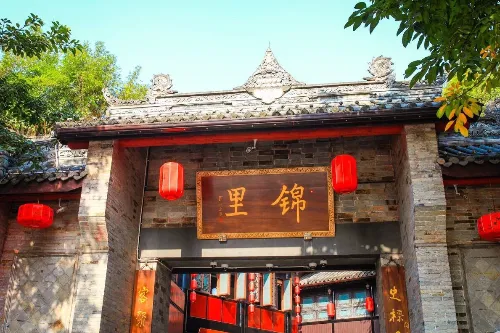
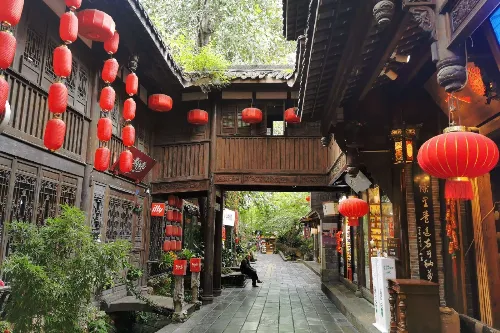
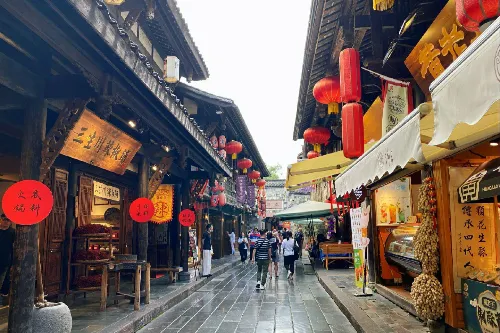
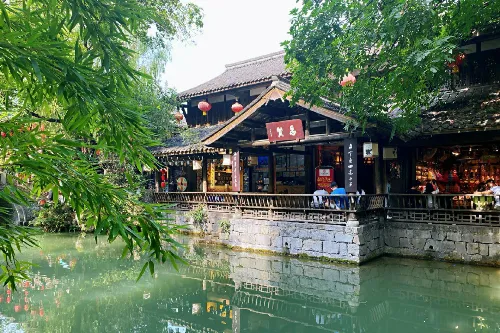
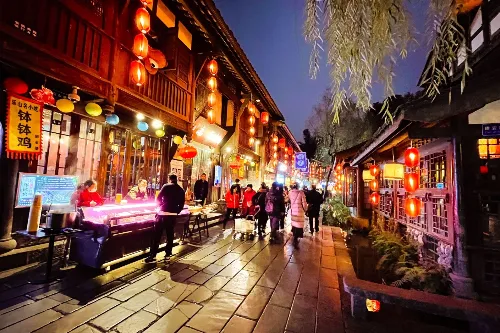
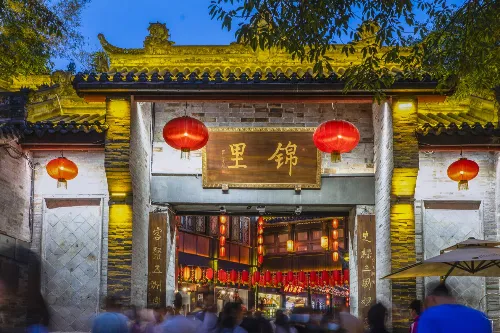
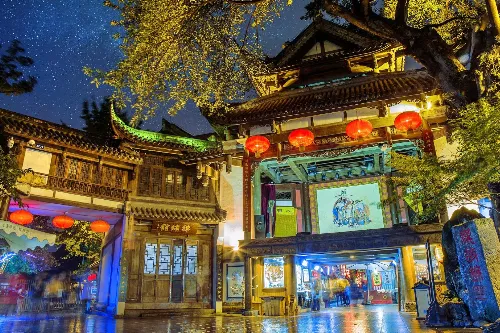
Ancient Stage
As a key venue for events such as performances by the Jinli Folk Art Troupe, it not only retains the basic structure of traditional Chinese stages with "Chujiang" (the entrance for performers playing positive roles) and "Ruxiang" (the entrance for performers playing negative roles). The building also uses ancient wood carved with Three Kingdoms stories as construction materials. Here, visitors can enjoy wonderful performances such as Sichuan Opera and folk music, and experience the unique charm of traditional culture.

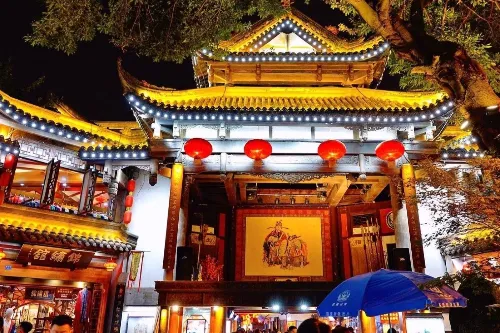
Jiupin Snack Street
The name "Jiupin" (Nine Ranks) not only refers to the "Nine-Rank System" – the official selection system of the Wei and Jin dynasties during the Three Kingdoms period, but also implies the rich variety of snacks on the street. Here, a large number of delicacies such as Zhang Fei Beef, Spicy Intestine Noodles, Ye'erba (glutinous rice cakes wrapped in leaves), Sandapao (glutinous rice balls tossed and hit three times), Boboji (spicy skewered chicken), and Tangyouguozi (fried glutinous rice balls with sugar coating) gather together, which can greatly satisfy visitors' taste buds.
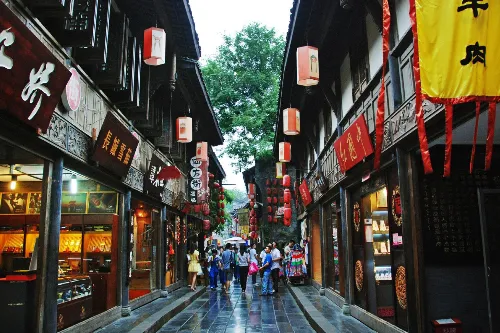
Zhuge Well
Surrounded by stone railings on the south, west and north sides, the well cover is made of stone, with a hollowed-out design in the shape of a copper coin, giving it a simple and heavy appearance. According to legend, this well was dug by Zhuge Liang to benefit the people. Although the original well was not located here, the people of Chengdu have a deep affection for Zhuge Liang, so Zhuge Well was built beside Jinli to express their memory and respect for him.
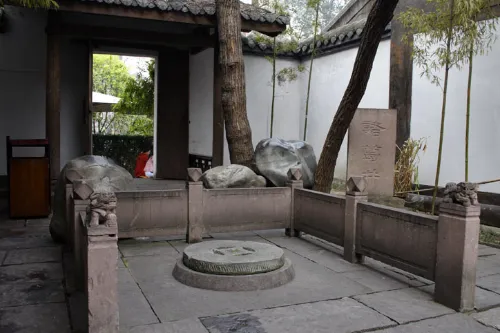
Adou Well
According to legend, after Liu Bei's death, his son Liu Chan (also known as Adou) went to Huiling (Liu Bei's mausoleum) every year to pay tribute to his father. Each time he passed by a well, he would stop to rest. Later generations thus named this well "Adou Well".
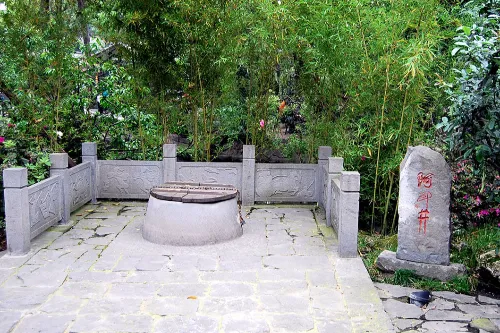
The First Archway of Western Sichuan
Located in the most prosperous area of the ancient neighborhood, it is surrounded by teahouses, inns, stages, local snack shops, folk handicraft stores and other establishments. It is a landmark archway of Jinli and also serves as the boundary between the first phase of Jinli and the second phase (Jinli by the Water).
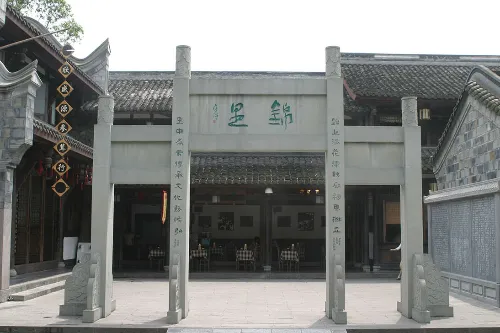
Fushou Lane
It implies "blessing" at the entrance of the lane and "longevity" at the end. The architectural colors mainly combine dignified gray tones with modern white tones, highlighting the delicate and elegant overall architectural style of Fushou Lane.

Huanglongtan Pond
Located in the depths of Jinli Ancient Street, it is one of the core popular areas. The water scenery here is highly attractive, often attracting visitors and local residents to drink tea and rest around it. Its name comes from the era name used by Sun Quan of the Eastern Wu regime (during the Three Kingdoms period). There is a small bridge and Fengyi Pavilion built on Huanglongtan Pond. Fengyi Pavilion is derived from "Romance of the Three Kingdoms", which tells the story of Diao Chan and Lü Bu having a private meeting here, which was witnessed by Dong Zhuo, eventually leading to the falling-out between Dong Zhuo and Lü Bu.
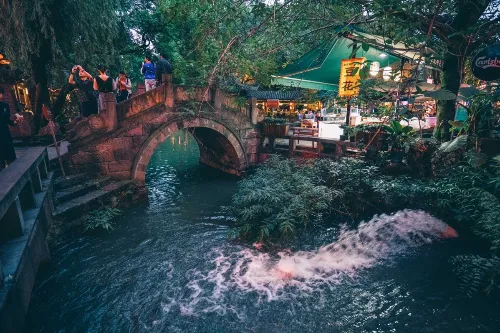
Folk Culture Memory Wall
It was completed on January 23, 2009. The wall houses representative works of Western Sichuan folk culture treasures, such as Shu Brocade, Shu Embroidery, bamboo-woven plates with porcelain bases, Chengdu lacquerware, shadow puppets, paper-cutting, eggshell paintings, sugar paintings, dough figurines, and old toys. The Jinli Folk Culture Memory Wall is planned to be opened on the same day in 2109, a hundred years later. The items sealed inside the wall will become a precious gift for the future, helping to pass on traditional folk culture for a century.
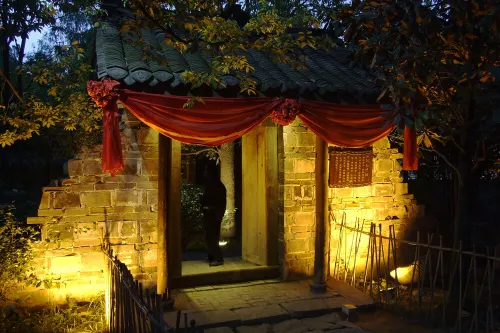
Song Dynasty Stone Carving Corridor
Located in the middle section of Yanxi Avenue in Jinli, it is about 120 meters long. A total of 111 stone carvings from the Song Dynasty are displayed in sequence on the west stone wall of the corridor. These stone carvings were collected one after another from central and southern Sichuan at the beginning of this century. Their artistic style is consistent with the Southern Song Dynasty stone carvings in Luzhou and other places, and they possess extremely high artistic and historical value.
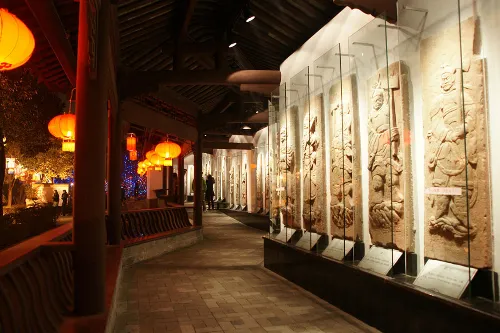
Liu Xiang's Mausoleum
The mausoleum covers an area of 86,000 square meters and adopts the architectural style of the Qing Dynasty imperial mausoleums in Beijing, with symmetrical lines. The tombstone is inscribed with "The Mausoleum of Liu Xiang, Commander-in-Chief of the 7th War Zone and First-Class Senior General of the Army During the War of Resistance Against Japanese Aggression".
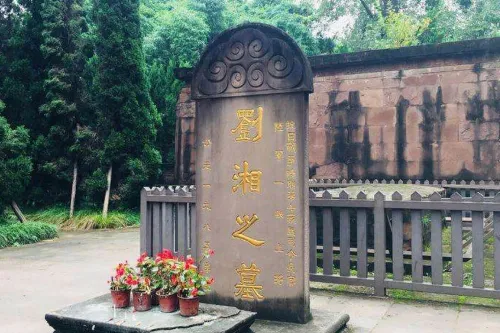
Tour Route
You can enter through the main gate of Jinli Ancient Street. First, visit The First Archway of Western Sichuan to experience its ancient charm. Then, stroll along the ancient street, admire the antique-style buildings, and visit scenic spots such as Fushou Lane and Huanglongtan Pond in sequence. When you reach Jiupin Snack Street, enjoy tasting the characteristic delicacies to your heart's content. After that, head to the Ancient Stage—if there is a performance happening, you can sit down and watch it. Next, go to Zhuge Well to learn about the historical story behind it. Finally, you can visit the Folk Culture Memory Wall and the Song Dynasty Stone Carving Corridor to feel the charm of culture. If you have extra time, you can sit in a street-side teahouse and experience the slow-paced life of Chengdu. If you want to enjoy the night view, you can enter in the evening to appreciate the unique atmosphere of the ancient street under the glow of red lanterns. If you plan to visit Wuhou Temple at the same time, it is recommended to tour Wuhou Temple in the afternoon and go to Jinli in the evening, as the two are only separated by a wall.
Travel Tips
- Visit Jinli at night—when the red lanterns are lit, the lights and the ancient street buildings complement each other, creating a strong festive atmosphere and perfect conditions for taking photos.
- You can check the performance schedule of the Ancient Stage online in advance to arrange your itinerary properly and not miss the wonderful shows.
- Wear comfortable shoes, as you will need to walk for a long time while touring the ancient street.
- When tasting food, you can try several kinds of specialty snacks to experience different flavors. However, most snacks in Jinli are relatively spicy, so visitors who are not good at eating spicy food should inform the store in advance.
- If you are interested in the Three Kingdoms culture, you can learn relevant knowledge before your trip, which will help you better understand the cultural connotation of Jinli.
Notes
- Jinli Ancient Street is always crowded with tourists, especially during holidays and at night. Please take good care of your personal belongings.
- Some shops in the ancient street may have relatively high prices. Before purchasing goods or tasting food, you can ask about the prices first.
- When watching folk performances, please abide by the on-site order and do not make loud noises.
- Respect the local customs and habits. If you participate in some folk activities, you must follow the relevant rules.
- There are some ancient buildings and cultural facilities in the ancient street. Do not touch or carve on them randomly, and work together to protect the scenic environment and cultural heritage.
Transportation
- Bus: There are three bus stops at the entrance of Jinli Ancient Street, with nearly 20 bus routes passing by. You can choose the appropriate bus route according to your departure location to reach the destination.
- Subway: You can take Metro Line 3 or Line 5, get off at Gaoshengqiao Station, exit from Exit D or Exit E, and walk to Jinli Ancient Street.
- Self-driving: For visitors driving by themselves, there are parking lots around Jinli. However, parking spaces may be tight during peak periods such as holidays. You need to plan your trip and parking in advance.
Opening Hours
It is open 24 hours a day, but the main light displays will be gradually turned off at 22:00.
Tickets
Admission to Jinli Ancient Street is free. However, some scenic spots and experience projects require separate fees.
Online Booking
Click here to jump to the Trip.com ticketing platform for ticket purchase.


